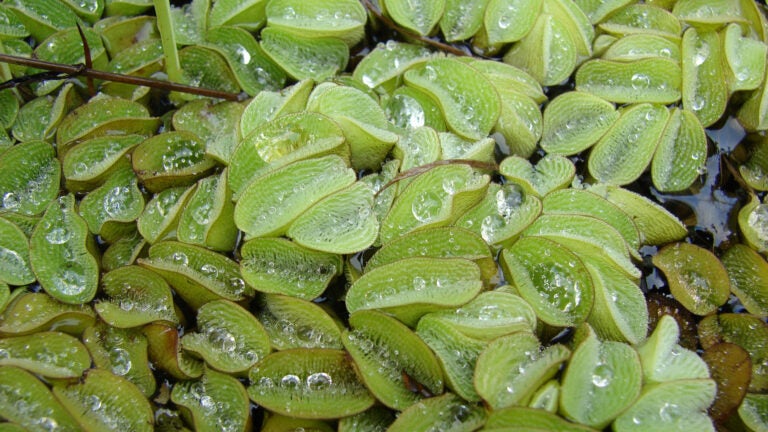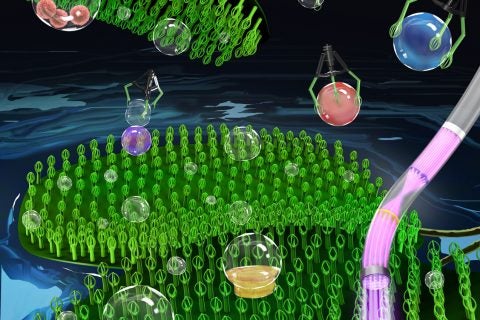
A USC Viterbi team used a 3-D printer to make a structure with properties similar to this South American floating fern. The material can separate oil and water and could be useful in oil spill cleanups. (Photo/Forest and Kim Starr)
Plant-inspired material could help clean up oil spills
USC scientists seek solutions to man-made disasters that have devastating environmental and economic consequences
Taking a cue from the structure of leaves, a new USC Viterbi School of Engineering study has fabricated a material that can separate oil and water, which could lead to safer and more efficient methods of cleaning up oil spills.
The material also is capable of “microdroplet manipulation,” the transfer of tiny volumes of liquid.
Using 3-D printing, Associate Professor Yong Chen and his research team at USC Viterbi’s Daniel J. Epstein Department of Industrial & Systems Engineering have successfully mimicked a biological phenomenon in plant leaves called the “Salvinia effect.” The study examines a floating fern native to South America called Salvinia molesta.
The fern’s unique leaves are super-hydrophobic — “water-fearing” — and retain a surrounding air pocket when submerged in water due to the presence of water-resistant hairs.
“I think the reason the plant’s surface is super-hydrophobic is because it lives on the water and requires air to survive,” said Yang Yang, a postdoctoral researcher on Chen’s team. “If it weren’t for the long-term evolution of this plant, the plant could be submerged in water and would die.”
Water-repellent structure

On a microscopic level, the leaf hairs align in a structure resembling an egg-beater, or cooking whisk, that is super-hydrophobic. Using a 3-D printing technique, the research team successfully created the egg-beater microstructure in samples made from plastic and carbon nanotubes.
The method allowed the team to demonstrate the fabrication of a material with both super-hydrophobic and oil-absorbing properties that, when combined, produce highly efficient oil and water separation, Chen said.
“We tried to create one functional surface texture that would be able to separate oil from water,” Chen said. “Basically, we modified the surface of the materials by using a 3-D printing approach that helped us achieve some interesting surface properties.”
Cleaning up oil spills
The team has 3-D printed a prototype, citing a growing demand for materials that can separate oil and water mixtures efficiently in vast bodies of water. Eventually, the researchers hope the technology can be applied to manufacture materials in large scale and accommodate massive oil spills in the ocean. Current methods require tremendous energy in the form of an electric field or mechanically applied pressure.
The Salvinia effect also has the potential for liquid-handling technology that executes microdroplet manipulation — a breakthrough where the adhesion of liquid to a robotic arm can be tuned accordingly and result in the efficient transfer for tiny amounts of liquid.
Watch a video about the technology. (Story continues below.)
Medical applications
Xiangjia Li, a PhD student on Chen’s team, said one example of high-performance microdroplet manipulation could lead to more efficient blood analyses for patients.
A robotic gripper could move to different stations and dispense microdroplets of blood that are then evenly mixed with different chemicals for various tests. In addition, the tests could be designed to control the ratio of chemical to droplet and result in significant conservation for source materials and chemical reagents.
“You can have a robotic arm with a gripper made to mimic Salvinia effect,” Li said. “No matter which way you move the arm, the gripping force is so large that a droplet will stay attached.”
Led by Chen, the research team also included Yang, Li, Professor Qifa Zhou and graduate students Xuan Zheng and Zeyu Chen. The team’s study was published in Advanced Materials.



